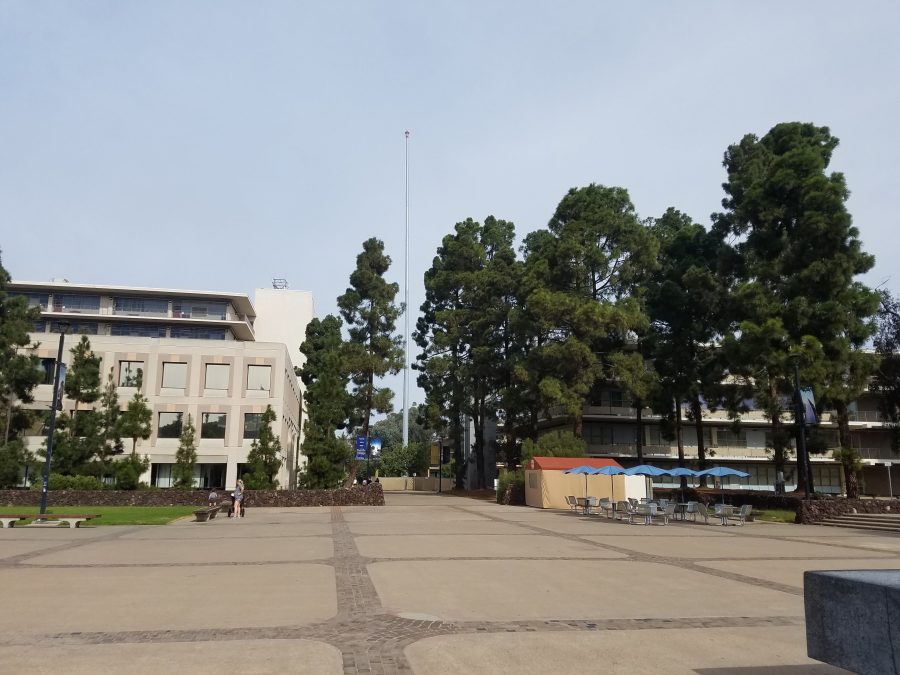On May 24, 1844, Samuel Morse sent the world’s first telegraph message to a friend in Baltimore, Maryland. A mere four words signaled the dawn of the coming technological age: “What hath God wrought?” Morse chose this message as a direct reference to the Bible’s Book of Numbers, referring to the Israelites’ destiny to inherit the holy land. In the century that bound the promised land of the United States together by a railroad waistband, it probably seemed as though the future would continue to bring people closer together through the rise of technology and modernization. Nearly 200 years later, Samuel Morse perhaps could not have anticipated just how distant we’ve become.
The most recent installation by the Stuart Collection has been gathering a lot of attention, as well as mixed reactions. “What Hath God Wrought” stands at over 190 feet tall, making it the tallest structure on campus. It’s a colossal, bland-looking metal monolith that blinks its title in Morse code from a light at the top. The Collection declared it a testament to technological achievements, and others think that the new piece in Roger Revelle College is either overly simplistic or just ironic. With a name like “What Hath God Wrought,” the first impression people might get, much like I did, is “What have we done?” and “Why did we bring this into the world?” You might even be vaguely reminded of the infamous phrase describing the Hindenburg disaster, “Oh, the humanity!” And yet, perhaps no other piece on campus truly encapsulates the current state of the school than “What Hath God Wrought.”
Looking at it from the base, it’s easy to understand why many people find it difficult to appreciate the work. It appears as nothing more than an industrial-looking metal pole that stretches up to the heavens and blinks. Aesthetically, it doesn’t seem to stand out too much from the washed-out brutalist style of the neighboring buildings. From a distance, however, this piece takes on a different connotation.
For miles, you can see the light peeking up over the rooftops of the university, flashing its message of dismay. To incoming students, it may seem like a lighthouse shining out a distress signal in the night, averting young minds away from the stormy waters and rocky shores of financial debt, heightened anxiety, and social alienation.
Alternatively, from the titular reference to the advent of communicative technology with a religious undertone, one could infer that this pole acts symbolically like a modern-day tower of Babel, if not for the sheer magnitude of the installation. We live in a time in which telephones doubling as supercomputers fit in our pockets. With the rapid evolution of communication and information just over the past decade alone, we’re perhaps closer to touching the heavens than we’ve ever been before. And yet, like speaking in different tongues, we can’t help but feel a deep-seated disconnect between ourselves and the people immediately surrounding us. This isolation should be especially evident at a school aptly nicknamed for its “socially dead” atmosphere.
Take a brisk stroll down Library Walk at virtually any time during the day, and there will be no shortage of examples of this. You won’t be able to go five minutes without someone nearly ramming into others because they can’t be bothered to look up from their phones. Student organization rushes consistently struggle to draw people in when a good portion of their potential audience is blocking out the world with headphones.
We attend a world-renowned research university that still struggles to respond to the very valid concerns of its massive student body. The school continues to over-admit students and overcrowd the dorms, while also forcing people to move off-campus. They certainly haven’t improved the quality of our meal plans, and food insecurity is an issue that affects a number of students. Parking is a pervasive issue that needs no elaboration. Even as we recognize the shortcomings of the university and its administrators, we largely take to a virtual soapbox to voice our discontent. Sharing memes and huddling together in the social simulacrum for ideological warmth hasn’t won us any battles. Like Dr. Frankenstein horrified by his own creation, contemporary thinkers and scholars are at odds with their own school. And yet, even in a time in which communication is easier than ever, we can’t seem to effectively get the point across.
A testament to the folly of human achievement, “What Hath God Wrought” is the perfect summation of this school’s various successes and the shortcomings that keep pace with them. Students flock from around the world to a supposed school of flowing milk and honey, only to find that it’s not all what they envisioned. “What Hath God Wrought” might be the Stuart Collection’s most self-aware piece to date. Its message is vexed, nuanced, sublime, and brilliant.









Alan Picard • Feb 28, 2025 at 3:53 pm
With the disheartening ascent of the Current Occupant (White House) and immediate plunge into chaos that was inevitable, the new phrase should be:
WHAT HATH ROT WROGHT?